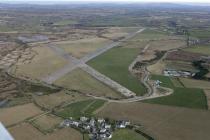Gellir lawrlwytho cynnwys at ddefnydd anfasnachol, megis defnydd personol neu ar gyfer adnoddau addysgol.
Ar gyfer defnydd masnachol cysyllwch yn uniongyrchol gyda deilydd yr hawlfraint os gwelwch yn dda.
Read more about the The Creative Archive Licence.
Disgrifiad
RCAHMW digital colour oblique photograph of Valley Airfield, Rhosneigr. Taken on 20/03/2005 by T.G. Driver.
Construction of the airfield at Valley, Rhosneigr, began with the levelling of sand dunes at Trewan and the installation of three runways NW/SE 1463m (4800ft), N/S 1188m (3900ft) and NE/SW 1280m (4200ft). Five radar stations were also built at Castell Mawr, Rhuddlan, South Stack, Nefyn and Pen-y-Bryn, and supplemented by a Ground Controlled Interception station (GCI) named Trewan Sands. The station's first control centre was the Chapel Hall at Caergeiliog. In the autumn of 1941, a decoy was built 9 miles to the south at Newborough Warren. Towards the end of 1941, it was proposed to lengthen the main runway by nearly 914m (3000ft) in preparation for transatlantic ferrying. In September and October 1942, further developments a 329m (1080ft) extension was built to the southern end of the NW-SE runway, and the ground levelled at both ends of the NE-SW runways. Further improvements were made into the 1950s, including new brick buildings, the renovation of hangars, the replacement of the Blister hangars and the resurfacing of the taxi-ways. A beacon to assist aircrews was located on Britannia Island, Menai Strait. The airfield had a long-standing problem with wind-blown sand until May 1942 when it was decided to use dredged silt from a small lake nearby to spread over the airfield to encourage stabilisation of the sand dunes. This dredging activity led to the discovery of the Lyn Cerrig Bach Iron Age hoard.
Event and Historical Information:
The airfield was opened on 1 February 1941 as a Fighter Sector Station under 9 Group. The station was to provide air cover for Liverpool, the northwest and shipping in the Irish Sea. The original name was Rhosneigr but this was changed to Valley on 5 April 1941. Hawker Hurricanes detached from 312 Squadron were first to use the airfield. These left on April 1941 and were replaced with Hurricanes from 615 Squadron. Night patrols were operated form Valley with Bristol Beaufighters from 219 Squadron from High Ercall. In October 1941, 275 Squadron was formed for air-sea rescue duties operating Westland Lysanders and Walruses, Boulton Paul Defiants and Avro Ansons. Over the next few years, a great number of flights and squadrons used Valley as a temporary base including; 242 Squadron, 350 Squadron, 131 Squadron, USAAF 414th Night Fighter Squadron, 125 Squadron, and 456 Squadron. A mountain rescue team was also formed at RAF Valley in August 1943. In the middle of 1944, there was a daily transatlantic C-54 service via Stephenville. The station's ferrying role was reversed in 1945 as American bombers passed through on their way back to the states for re-deployment. This traffic came to an end in September 1945. The airport was put on a care and maintenance basis in June 1947, but the decision was made to make the station a permanent base and many improvements were made to the buildings. In 1951, 202 Fighter Training Squadron (FTS) was formed using Vampires, to be followed by 7 FTS and 4 FTS. This function continues today in addition to air-sea rescue and guided weapons development.
Sources include:
Defence of Britain Project
Jones, I, 2008: Airfields and Landing Grounds of Wales; North, pg78-95
Phillips, Alan, 2006, Military Airfields Wales, pg 252-6
Sloan, Roy, 1991, Wings of War over Gwynedd, pg20-61
Smith, David J, 1982 Action Stations 3: Military Airfields of Wales and the North West, pg 196-200






Oes gennych chi wybodaeth ychwanegol am yr eitem hon? Gadewch sylwad isod
Sylwadau (0)
Rhaid mewngofnodi i bostio sylw